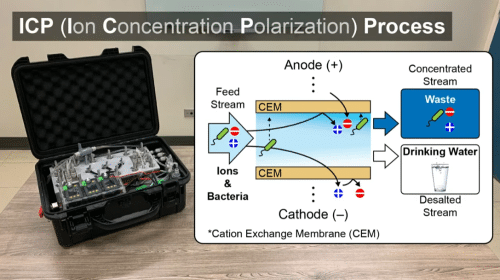A unit that generates clear, clean drinking water without the need for filters or high-pressure pumps.
MIT researchers have built a portable desalination equipment that can remove particles and salts to produce potable water and weighs less than 10 kg. A small, portable solar panel, which can be purchased online for roughly $50, can also power the suitcase-sized device, which uses less power than a cell phone charger. It automatically produces drinking water that meets or surpasses WHO quality criteria. The technology is housed in a user-friendly device that can be activated with a single button press.
Unlike previous portable desalination devices that require water to pass through filters, this gadget removes particulates from drinking water using electrical power. Long-term maintenance requirements are considerably reduced by eliminating the need for replacement filters.
High-pressure pumps are often used in commercially available portable desalination machines to force water through filters, which are difficult to miniaturise without compromising the device’s energy efficiency.
Instead, they use a technique known as ion concentration polarisation (ICP), which was developed by Han’s group over a decade ago. Instead of filtering water, the ICP technique uses an electrical field to apply to membranes above and below a water channel. Positively and negatively charged particles, such as salt molecules, bacteria, and viruses, are repelled by the membranes as they pass by. The charged particles are channelled into a second stream of water, which is discharged later.

Both dissolved and suspended particles are removed throughout the process, allowing clean water to travel through the channel. ICP uses less energy than other procedures because it simply requires a low-pressure pump. However, ICP does not always remove all of the salts floating in the channel. To eliminate any residual salt ions, the researchers used a second method known as electrodialysis.
The researchers also developed a smartphone app that can remotely manage the unit and provide real-time statistics on power consumption and water salinity. Through a firm he aims to form to market the idea, first author Junghyo Yoon, a research scientist in RLE (Research Laboratory of Electronics), hopes to make the gadget more user-friendly while also improving its energy efficiency and production rate.
Senior author Jongyoon Han, Professor of Electrical Engineering and Computer Science and a member of RLE, hopes to use the lessons he’s learned in the lab to address water-quality challenges other than desalination, such as quickly detecting pollutants in drinking water. The research has been published online in Environmental Science and Technology.
“It was successful even in its first run, which was quite exciting and surprising. But I think the main reason we were successful is the accumulation of all these little advances that we made along the way,” Han says.
Watch their demonstration here.





